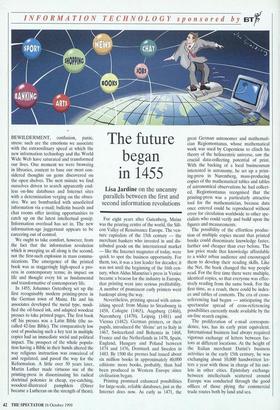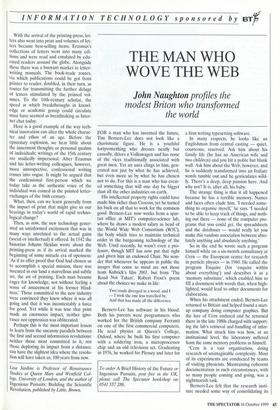INFORMATION TECHNOLOGY sponsored by BTf
The future began in 1455
Lisa Jardine on the uncanny parallels between the first and second information revolutions
BEWILDERMENT, confusion, panic, stress: such are the emotions we associate with the extraordinary speed at which the new information technology and the World Wide Web have saturated and transformed our lives. One moment we were browsing in libraries, content to base our most con- sidered thoughts on gems discovered on the open shelves. The next minute we find ourselves driven to search apparently end- less on-line databases and Internet sites with a determination verging on the obses- sive. We are bombarded with unsolicited information via e-mail; bulletin boards and chat rooms offer inviting opportunities to catch up on the latest intellectual gossip. Information overload has set in. The new information-age juggernaut appears to be careering out of control.
We ought to take comfort, however, from the fact that the information revolution which is sweeping us all along is the second, not the first-such explosion in mass commu- nications. The emergence of the printed book was as staggeringly high-speed a pro- cess in contemporary terms; its impact on life and thought every bit as fundamental and transformative of contemporary life.
In 1455, Johannes Gutenberg set up the first recognisably modern printing-press in the German town of Mainz. He and his associates developed the metal type, modi- fied the oil-based ink, and adapted woodcut presses to take printed pages. The first book off his presses was a Latin Bible (the so- called 42-line Bible). The comparatively low cost of producing such a key text in multiple copies had an immediate social and political impact. The prospect of the whole popula- tion having a Bible in their hands altered the way religious instruction was conceived of and regulated, and paved the way for the Reformation. A little over 50 years later, Martin Luther made virtuoso use of the printing-press in disseminating his radical doctrinal polemics in cheap, eye-catching, woodcut-illustrated pamphlets (Diirer became a Lutheran on the strength of them).
For eight years after Gutenberg, Mainz was the printing centre of the world, the Sili- con Valley of Renaissance Europe. The ven- ture capitalists of the 15th century — the merchant bankers who invested in and dis- tributed goods on the international market — like the Internet magnates of today, were quick to spot the business opportunity. For them, too, it was a loss leader for decades; it was not until the beginning of the 16th cen- tury, when Aldus Manutius's press in Venice became a beacon for the industry in Europe, that printing went into serious profitability. A number of prominent early printers went bankrupt along the way.
Nevertheless, printing spread with aston- ishing speed: from Mainz to Strasbourg in 1458, Cologne (1465), Augsburg (1468), Nuremberg (1470), Leipzig (1481) and Vienna (1482). German printers, or their pupils, introduced the 'divine' art to Italy in 1467, Switzerland and Bohemia in 1468, France and the Netherlands in 1470, Spain, England, Hungary and Poland between 1474 and 1476, Denmark and Sweden in 1483. By 1500 the presses had issued about six million books in approximately 40,000 editions: more books, probably, than had been produced in Western Europe since civilisation began.
Printing promised enhanced possibilities for large-scale, reliable databases, just as the Internet does now. As early as 1471, the great German astronomer and mathemati- cian Regiomontanus, whose mathematical work was used by Copernicus to clinch his theory of the heliocentric universe, saw the crucial data-collecting potential of print. With the backing of a local businessman interested in astronomy, he set up a print- ing-press in Nuremberg, mass-producing copies of the mathematical tables and tables of astronomical observations he had collect- ed. Regiomontanus recognised that the printing-press was a particularly attractive tool for the mathematician, because data once entered could be reproduced without error for circulation worldwide to other spe- cialists who could verify and build upon the figures and measurements.
The possibility of the effortless produc- tion of multiple copies meant that printed books could disseminate knowledge faster, further and cheaper than ever before. The low price made that knowledge affordable to a wider urban audience and encouraged them to develop their reading skills. Like the Net, the book changed the way people read. For the first time there were multiple, identical copies, so that everyone was effec- tively reading from the same book. For the first time, as a result, there could be index- es and tables of contents. The era of cross- referencing had begun — anticipating the spectacular spread of cross-referencing possibilities currently made available by the on-line search engine.
The proliferation of e-mail correspon- dence, too, has its early print equivalent. International business had always required vigorous exchange of letters between fac- tors at different locations. At the height of the Italian merchant Datini's business activities in the early 15th century, he was exchanging about 10,000 handwritten let- ters a year with those in charge of his out- lets in other cities. Epistolary exchange between intellectuals scattered around Europe was conducted through the good offices of those plying the commercial trade routes both by land and sea.
With the arrival of the printing-press, let- ters also went into print and volumes of let- ters became best-selling items. Erasmus's collections of letters went into many edi- tions and were read and emulated by edu- cated readers around the globe. Alongside these there was a buoyant market in letter- writing manuals. The book-trade routes, via which publications could be got from printer to reader, doubled, in their turn, as routes for transmitting the further deluge of letters stimulated by the printed vol- umes. To the 16th-century scholar, the speed at which breakthroughs in knowl- edge or academic gossip could circulate must have seemed as breathtaking as Inter- net chat today.
Here is a good example of the way tech- nical innovation can alter the whole charac- ter and ethos of an age. Before the epistolary explosion, we hear little about the innermost thoughts or personal qualms of individuals; writings of the 15th century are studiedly impersonal. After Erasmus and his letter-writing colleagues, however, more introspective, confessional writing comes into vogue. It might be argued that the confessional first-person which we today take as the authentic voice of the individual was coined in the printed letter- exchanges of the 16th century.
What, then, can we learn generally from the impact of print that might give us our bearings in today's world of rapid techno- logical change?
Then, as now, the new technology gener- ated an uninformed excitement that was in many ways unrelated to the actual gains (social or intellectual) it offered. In 1542 the historian Johann Sleidan wrote about the printing-press as if its arrival marked the beginning of some miracle era of openness: 'As if to offer proof that God had chosen us to accomplish a special mission, there was invented in our land a marvellous and subtle art, the art of printing. Each man became eager for knowledge, not without feeling a sense of amazement at his former blind- ness.' Those committed to the new industry were convinced they knew where it was all going and that it was incontestably a force for good. Yet while it was true that print made an enormous impact, neither igno- rance nor oppression was obliterated.
Perhaps this is the most important lesson to learn from the uncanny parallels between the first and second information revolutions: neither those most committed to it, nor those deploring its impact from a distance, can have the slightest idea where the revolu- tion will have taken us, 100 years from now.
Lisa Jardine is Professor of Renaissance Studies at Queen Mary and Westfield Col- lege, University of London, and the author of Ingenious Pursuits: Building the Scientific Revolution, published by Little, Brown.



















































































 Previous page
Previous page